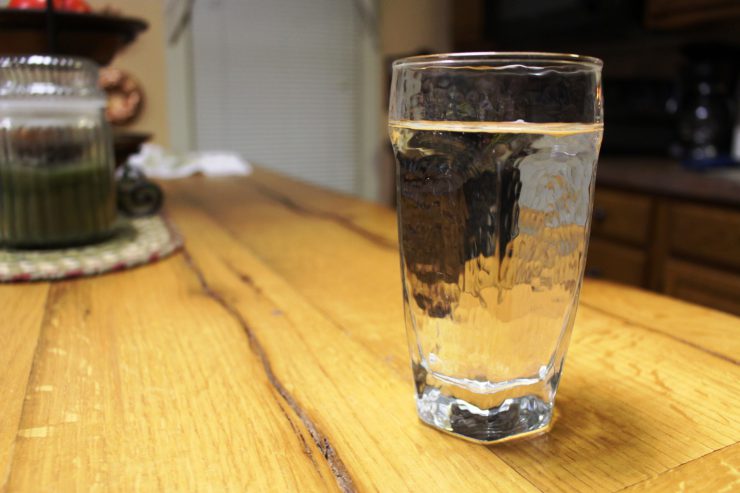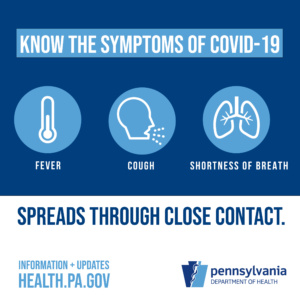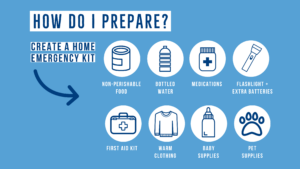Lead Level of 428 ppb in Lititz Home Omitted from Borough Water Quality Report
LITITZ, PA-The result of a tap water test in Lititz Borough that far exceeded federal limits for levels of lead in tap water was omitted from a 2012 Annual Drinking Water Quality Report by Severn Trent Environmental Services, Inc. sent to residents of the borough, according to documents provided by the borough to LititzDailyNews.com yesterday under the Right-to-Know Law.
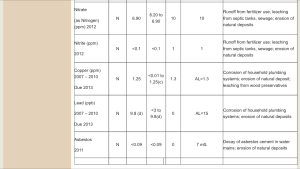
A page from the 2012 water quality report shows an upper limit range for lead at 9.8 ppb for 2010. A 428 ppb test result was omitted from the report. Screenshot from LititzBorough.org.
The report, which features the results of lead testing in tap water in Lititz Borough during 2010 and is supposed to notify residents if any borough water samples exceeded the Action Level of 15 parts per billion, made no mention of the test result for a Front Street home where lead in tap water was discovered at 428 parts per billion, more than 28 times the amount allowed by federal law.
The majority of homes in Flint, Michigan with elevated levels of lead tested around 150 ppb of lead in December, more than 10 times the federal limit.
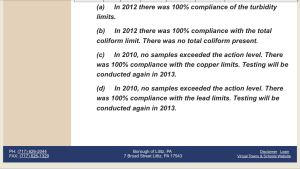
Detail from the 2012 Lititz Borough Water Quality Report. A lead level of 428 ppb was measured but not published. Screenshot from LititzBorough.org.
The extremely high level of lead was not published in the 2012 Annual Drinking Water Quality Report, which states that “In 2010, no samples exceeded the action level. There was 100% compliance with the lead limits.” The sample that exceeded the Action Level of 15 ppb was collected on August 12, 2010, according to the results report provided yesterday by Lititz Borough manager Sue Barry in response to a RTKL request. The omission of the test result from the 2012 ADWQR may be a violation of state and federal law.
On February 3, Lititz Borough posted a statement regarding water drinking water quality to the Lititz borough website, which said in part: “”First, the annual water quality reports indicate that Lititz Borough is in compliance with, and meets, all federal and state drinking water requirements. The annual water quality reports are available to all customers each year.”
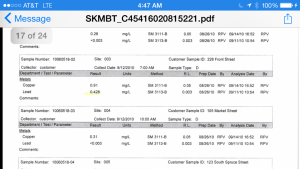
Results of a 2010 tap water test in Lititz Borough home revealed at level of 428 ppb (converted from .428 mg/L shown above) at 228 Front St, more than 28 times the federal limit for lead in drinking water.
But somehow the test result for tap water from a home at 228 Front Street sampled in 2010 was omitted from at least one annual water quality report in 2012, and possibly more. The 428 ppb lead level should have been reported to residents in three places in the annual drinking water quality reports for three consecutive years-from 2010 through 2012-until results of the 2013 tests were published.
The 428 ppb sample value should have appeared in columns marked Maximum Level Detected and as the highest sample in the Range column, right next to the desired level of zero and the Allowable Limit of 15 ppb. Had the result appeared as required by the EPA, residents could easily have seen there was at least one home where lead was a serious concern. The home does not appear to have been tested again by Severn Trent in 2013. LititzDailyNews.com is in the process of obtaining the two other water quality reports and additional documents regarding water quality in the borough.
“We don’t think there is a concern,” said Barry in an interview today, while acknowledging that lead pipes connect Lititz residents to the borough water supply. Still, residents have questions about the levels of lead in their
RELATED STORY: WARWICK TOWNSHIP HAS REPORTED LEAD AT SAME LEVELS AS FLINT
“If they’re concerned, they can get their own water tested,” said Barry, who does not live in the borough. “It’s not coming from the source.” Lead at the source of drinking water is rarely an issue, but the quality of the water can contribute to corrosion of lead pipes, releasing the toxic metal into the water. The pH can impact corrosivity of water, and water systems treat to reduce corrosion.
“We don’t think there is a concern.”-Sue Barry, Lititz Borough Manager, on water quality in Lititz Borough.
“If my tap had a tested lead level of 428 parts per billion, I’d be very concerned,” said Bob Wendlegass, President and CEO of Clean Water Action, a national organization that works to protect the environment, health, economic well-being and community quality of life. “That’s a terribly high number and I wouldn’t want to expose my family to it, and I don’t think anybody would want to expose their family to it.
Barry, who managed the borough 2010, said this afternoon that she referred questions over the high lead level in 2010 and its omission from the 2012 ADWQR to Mike Wolgemuth, project manager for Severn Trent, today. Wolgemuth was not available to comment by phone this afternoon, according to a woman who answered the phone at the Lititz office of Severn Trent but refused to identify herself before hanging up.
LititzDailyNews.com has also contacted press representatives for Pennsylvania Department of Environmental Protection and the US DEP Region 3 office, who have yet to respond regarding the omission of the high level from the annual report and oversight issues.
In response to a question of whether a child in Pennsylvania was at greater risk for lead exposure than a child in Flint during a call with media on Friday, Pennsylvania Department of Health Secretary Karen Murphy replied that “The issue here is not contamination of the water.” Murphy emphasized that lead-based paint in older homes presents a greater hazard to children.
“The most positive thing you can do is to prevent lead from getting into children,” said Dr. Janet Currie, a professor of Economics and Policy Affairs at Princeton University who has studied the connection between educational achievement and lead contamination in Rhode Island, where 80% of all children are tested for lead levels in their blood. “Once you have lead in your brain, you can’t get it out again. It’s a permanent problem,” said Currie.
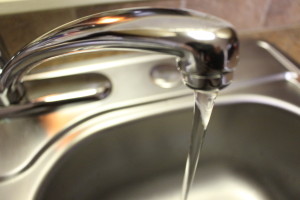
Water runs from the tap that tested at 428 ppb in a Lititz Borough home. Photo by Lynn Rebuck/LititzDailyNews.com
Currie believes changes could be made which will have a positive impact on lead issues affecting children, including those who deal with lead in their drinking water.
“The whole thing in Flint just revealed the problem with lead pipes, so maybe more aggressive testing of water and more help for people who are affected-things like filters for the water or bottled water-until they can get some other solution,” said Currie. “It’s not rocket science. We know what to do, we just don’t always do it.”
Most of the lead levels in water reported for Lititz Borough in 2010 were low, but the EPA states that there is no safe level of lead in drinking water. Regulations established by the EPA and Pennsylvania Department of Environmental Protection require Lititz Borough to collect 20 tap water samples from the homes at highest risk for contamination with lead and copper every three years.

A glass of water from 228 Front Street in Lititz, where levels of lead were measured at 428 ppb in 2010. Photo by Lynn Rebuck/LititzDailyNews.com
It was unclear from the documents provided to LititzDailyNews.com yesterday whether the borough tested homes at highest risk in Lititz Borough. Water providers are required to submit identification of samples according to the three-tier system mandated by the EPA to ensure that the limited number of samples is reflective of the risk in the community. The tier classifications were not evident on the documents received.
Water providers are required to report the 90th percentile level of the samples collected, a practice that allows them to notify residents of a calculation that is not connected with safety or health outcomes while omitting 10 percent of samples that tested higher. The 90th percentile value for Lititz Borough water was 7 ppb in 2010. Providers are still required to inform residents in the ADWQR of the number of samples found to be over the Action Level. The 2012 ADRQR report shows a range of lead levels for 2007-2010 from <3 to 9.8 ppb. The 428 ppb was omitted from the report.
In 2013, Lititz Borough Water and Severn Trent reported the 90th percentile level in borough water at 5 ppb. The 2014 ADWQR on the borough website states that no levels exceeded the action level during 2013. No sample testing from 228 Front Street was reported in the 2013 results provided under the Right-to-Know Law request.
According to lead and copper monitoring guidelines for water providers published in 2002, once a water system begins monitoring, it must “use the same sites unless a site is no longer accessible” or “no longer fits the requirements of a priority site (e.g. lead service lines that served the site have been replaced). No service line replacement were made, according to the homeowner, who hopes to take part in the 2016 lead testing by the borough.
The borough is due to test for lead and copper in tap water samples between June 1 and September 30, considered to be the time period when lead levels are usually at their highest.
Homes considered to be at high risk for lead contamination in water are those that have lead pipes, lead service lines, or copper pipes with lead solder. Other homes with different plumbing materials may also be at risk, as may businesses and apartment buildings.
The Pennsylvania DEP provides the following advice to consumers who wish to reduce their exposure to lead in drinking water:
“Since lead exposure in drinking water typically comes from your plumbing fixtures and not the source of your water supply, it’s important for both public drinking water customers as well as private well water users to follow these tips to reduce your exposure to lead.”
- Run your water to flush out lead. If water hasn’t been used for several hours, run water for 15-30 seconds or until it becomes cold or reaches a steady temperature before using it for drinking or cooking. This flushes out any stagnant water in your home plumbing and replaces it with fresh water from the water main in your street.
- Use cold water for cooking and preparing baby formula. Do not cook with or drink water from the hot water tap; lead dissolves more easily into hot water. Do not use water from the hot water tap to make baby formula.
- Do not boil water to remove lead. Boiling water will not reduce lead. In fact, lead concentrations will be higher in water that is boiled since some of the water is removed as steam.
- Test your water for lead. Contact your water system for more information about getting your water tested. Some water systems may offer to test your water free of charge. Your water system can also provide information about local laboratories that conduct lead testing. If you’re a private well water user, you should contact a DEP-accredited lab for information about water testing. Here is the link to a listing of DEP-accredited labs.
- Identify if your plumbing fixtures contain lead. There are lead check swabs that can detect lead on plumbing surfaces such as solder and pipes. These swabs can be purchased at plumbing and home improvement stores.
For more information, or to ask questions about your water service, residents may attend the monthly Lititz Borough Council meetings held on the fourth Tuesday of every month. The next meeting will take place on Tuesday, February 23, at 7 p.m. in the Borough Council Chambers, 7 S. Broad St., Lititz. The meeting is free and open to the public. For more information, call (717)626-2044.
If you wish to have your water tested, one lab in Lancaster County is certified to test for lead., Eurofins Lancaster Lab. The cost is only $30. Read more about it here.
